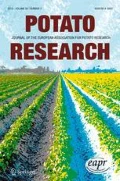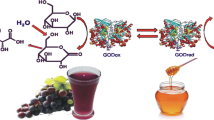Abstract
Acrylamide is an amide-type organic compound formed by the reaction of asparagine with reducing sugars (Maillard reaction) and is classified as a probable human carcinogen (Group 2A) by the International Agency for Research on Cancer. Potato chips are one of the foods that contribute most to dietary acrylamide intake, and despite a significant reduction in recent years thanks to changes in frying methods, many commercial samples show concentrations above the levels recommended by the European Commission Regulation 2017/2158. In this work, a high correlation (P<0.01) was established (r = 0.9592) between the content of reducing sugars and glucose measured by the BIOWINE 700 GLU® biosensor from Biolan Microbiosensors S.L. A high correlation was also obtained between the glucose content of the raw potato and the acrylamide level of potato chips fried at 150 °C (r = 0.8985, P<0.01) and 176 °C (r = 0.9949, P<0.01). The use of this biosensor can be a valuable tool for predicting acrylamide formation during industrial potato processing.





Similar content being viewed by others
References
Amrein TM, Schönbächler B, Rohner F, Lukac H, Schneider H, Keiser A, Escher F, Amadò R (2004) Potential for acrylamide formation in potatoes: data from the 2003 harvest. Eur Food Res Technol 219:572–578
Barredo A (1993) Development and analysis of methods for the selection of potato varieties for the industrial production of food products. Bachelor’s Project. University of Basque Country. Bilbao, Spain
Bethke PC (2018) Progress and successes of the specialty crop research initiative on acrylamide reduction in processed potato products. Am J Potato Res 95:328–337
De Wilde T, De Meulenaer B, Mestdagh F, Govaert Y, Ooghe W, Fraselle S, Demeulemeester K, Van Peteghem C, Calus A, Degroodt JM, Verhé R (2006) Selection criteria for potato tubers to minimize acrylamide formation during frying. J Agric Food Chem 54:2199–2205
Duarte-Delgado D, Ñústez-López CE, Narváez-Cuenca CE, Restrepo-Sánchez LP, Melo SE, Sarmiento F, Kushalappa AC, Mosquera-Vásquez T (2016) Natural variation of sucrose, glucose and fructose contents in Colombian genotypes of Solanum tuberosum Group Phureja at harvest. J Sci Food Agric 96:4288–4294
Duplessis PM, Marangoni AG, Yada RY (1996) A mechanism for low temperature induced sugar accumulation in stored potato tubers: the potential role of the alternative pathway and invertase. Am Potato J 73:483–494
EFSA (2015) Scientific Opinion on acrylamide in food. EFSA Journal 13
Elmore JS, Briddon A, Dodson AT, Muttucumaru N, Halford NG, Mottram DS (2015) Acrylamide in potato crisps prepared from 20 UK-grown varieties: effects of variety and tuber storage time. Food Chem 182:1–8
Friedman M (2003) Chemistry, biochemistry and safety of acrylamide. J Agric Food Chem 51:4504–4526
IARC (1994) Monographs on the evaluation of carcinogenic risks to humans. International Report 14/002. Lyon, France.
Li L, Tacke E, Hofferbert HR, Lübeck J, Strahwald J, Draffehn AM, Walkemeier B, Gebhardt C (2013) Validation of candidate gene markers for marker-assisted selection of potato cultivars with improved tuber quality. Theor Appl Genet 126:1039–1052
Lindsay H (1973) A colorimetric estimation of reducing sugars in potatoes with 3,5-dinitrosalicylic acid. Potato Res 16:176–179
Luthra SK, Gopal J, Kumar D, Singh BP, Pandey SK (2009) Solanum wild and cultivated species as source of resistance to cold induced sweetening. Potato J 36:115–120
Medeiros-Vinci R, Mestdagh F, De Meulenaer B (2012) Acrylamide formation in fried potato products - present and future, a critical review on mitigation strategies. Food Chem 133:1138–1154
Mesías M, Morales FJ (2015) Acrylamide in commercial potato crisps from Spanish market: trends from 2004 to 2014 and assessment of the dietary exposure. Food Chem Toxicol 81:104–110
Mottram DS, Wedzicha BL, Dodson AT (2002) Food chemistry: acrylamide is formed in the Maillard reaction. Nature 419:448–449
Muttucumaru N, Powers SJ, Elmore JS, Briddon A, Mottram DS, Halford NG (2014) Evidence for the complex relationship between free amino acid and sugar concentrations and acrylamide-forming potential in potato. Ann Appl Biol 164:286–300
Ohara-Takada AC, Matsuura-Endo Y, Chuda H, Ono H, Yada M, Yoshida A, Kobayashi S, Tsuda S, Takigawa T, Noda H, Yamauchi H, Motoyuki M (2005) Change in content of sugars and free amino acids in potato tubers under short-term storage at low temperature and the effect on acrylamide level after frying. Biosci Biotech Bioch 69:1232–1238
Ortega-Rivas E (2009) Processing effects on safety and quality of foods. Dan-Wen Sun ed. CRC Press. London. 28 pp
Parker JK, Balagiannis DP, Higley J, Smith G, Wedzicha BL, Mottram DS (2012) Kinetic model for the formation of acrylamide during the finish-frying of commercial French fries. J Agric Food Chem 60:9321–9331
Pedreschi F, Kaack K, Granby K, Troncosod E (2007) Acrylamide reduction under different pre-treatments in French fries. J Food Engin 79:1287–1294
Rosen C, Sun N, Olsen N, Thornton M, Pavek M, Knowles L, Knowless RN (2018) Impact of agronomic and storage practices on acrylamide in processed potatoes. Am J Potato Res 95:319–327
SAS Institute (2010) SAS Version 9.3. The SAS Institute Cary NC
Sowokinos JR (2001) Biochemical and molecular control of cold-induced sweetening in potatoes. Am J Potato Res 78:221–236
Stadler RH, Blank I, Varga N, Robert F, Hau J, Guy PA, Robert MC, Riediker S (2002) Food chemistry: acrylamide from Maillard reaction products. Nature 419:449–450
Sun N, Rosen CJ, Thompson AL (2018) Acrylamide formation in processed potatoes as affected by cultivar, nitrogen fertilization and storage time. Am J Potato Res 95:473–486
Timilsena YP, Khanal JS, Anal AK (2013) Acrylamide: thermally induced toxicant in foods and its control measures. J Food Sci Technol 6:19–30
Wang Y, Bethke PC, Bussan AJ, Glynn MT, Holm DG, Navarro FM, Novy RG, Palta JP, Pavek MJ, Porter GA, Sathuvalli VR, Thompson AL, Voglewede PJ, Whitworth JL, Parish D, Endelman JB (2016) Acrylamide-forming potential and agronomic properties of elite US potato germplasm from the national fry processing trial. Crop Sci 56:30–39
Yang Y, Achaerandio I, Pujolà M (2016) Influence of the frying process and potato cultivar on acrylamide formation in French fries. Food Control 62:216–223
Zhu F, Cai YZ, Ke J, Corke H (2010) Compositions of phenolic compounds, amino acids and reducing sugars in commercial potato varieties and their effects on acrylamide formation. J Sci Food Agric 90:2254–2262
Acknowledgements
This work was financed by the MICINN of Spain (Project PID2019-109790RR-C2) and the Basque Government. The authors thank the company Biolan Microbiosensors S.L. for providing the BIOWINE 700 GLU® biosensor. They also thank Alvaro Herrán, Olatz Barrena, and Ibernalo Martinez de Contrasta for their collaboration.
Author information
Authors and Affiliations
Corresponding author
Additional information
Publisher’s Note
Springer Nature remains neutral with regard to jurisdictional claims in published maps and institutional affiliations.
Rights and permissions
About this article
Cite this article
Alvarez-Morezuelas, A., Ortiz-Barredo, A., Barandalla, L. et al. Estimation of Glucose Content in Raw Potatoes with a Biosensor as an Indicator of Acrylamide Level in Processed Potatoes. Potato Res. 64, 601–609 (2021). https://doi.org/10.1007/s11540-021-09494-0
Received:
Accepted:
Published:
Issue Date:
DOI: https://doi.org/10.1007/s11540-021-09494-0




